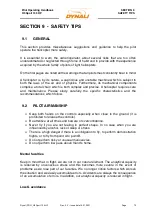
Pilot Operating Handbook
H3 Sport 135 HP
SECTION 9
SAFETY TIPS
Dynali_POH_H3 Sport 135 HP Rev. 3.3 – Issue date 15.01.2021 Page
79
realize their loss of depth perception when flying over water. Flying over calm glassy
water is particularly dangerous, but even choppy water, with its constantly varying
surface, interferes with normal depth perception and may cause a pilot to misjudge his
height above the water.
MAINTAIN SAFETY ALTITUDE AT ALL TIMES !
Conversion pilots constitute high risk when flying helicopters
There have been a number of fatal accidents involving experienced pilots who have
many hours in airplanes or gyroplanes but with only limited experience flying
helicopters.
The ingrained reactions and habits of an experienced airplane pilot can be deadly
when flying a helicopter. The airplane pilot may fly the helicopter well when doing
normal manoeuvres under ordinary conditions when there is time to think about the
proper control response. But when required to react suddenly under unexpected
circumstances, he may revert to his airplane reactions and commit a fatal error.
Under those conditions, his hands and feet move purely by reaction without conscious
thought. Those reactions may well be based on his greater experience, i.e., the
reactions developed flying airplanes.
For example, in an airplane his reaction to an engine failure would be to immediately
and considerably go forward with the stick. In a helicopter, application of inadequate
forward stick could result in a low-G situation or, if the engine failure occurred during
initial climb, a reduction of rotor RPM combined with a high sink rate with the
consequence of a hard landing or impact.
Airplane pilots may also underestimate pedal work. Especially in a helicopter, pedal
control is most critical as it has the highest rate response with the smallest static and
dynamic damping effect of all other controls. Being used to the high directional stability
of an airplane, a conversion pilot may neglect proper pedal. Very much like gyroplanes,
helicopters cannot be flown by control position or control force, but solely by resulting
attitude. That means that the pilot together with his built-in senses and programmed
reflexes represents a vital part in the active control feedback loop.
Gyroplane pilots, on the other hand, may underestimate the characteristics of
helicopters and the necessity for proper training.
To develop safe helicopter reactions, conversion pilots must practice each procedure
over and over again with a competent instructor until hands and feet will always make
the right move without requiring conscious thought.
AND, ABOVE ALL, HE MUST NEVER ABRUPTLY PUSH THE CONTROL STICK
FORWARD.
Содержание H3 Sport 135 HP
Страница 85: ......







































